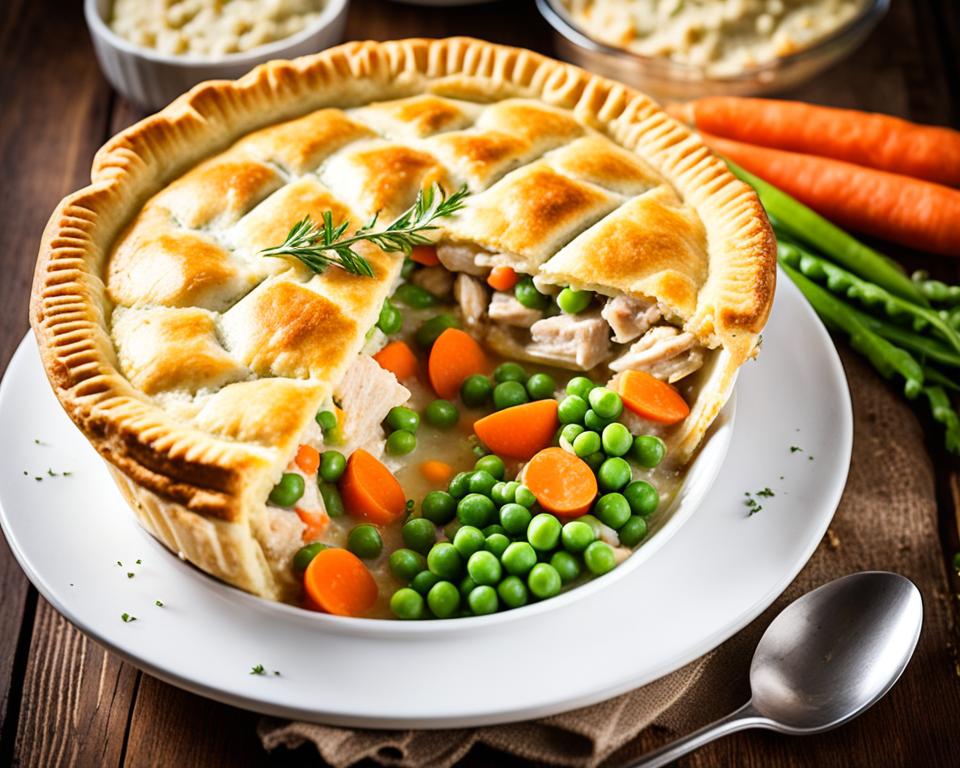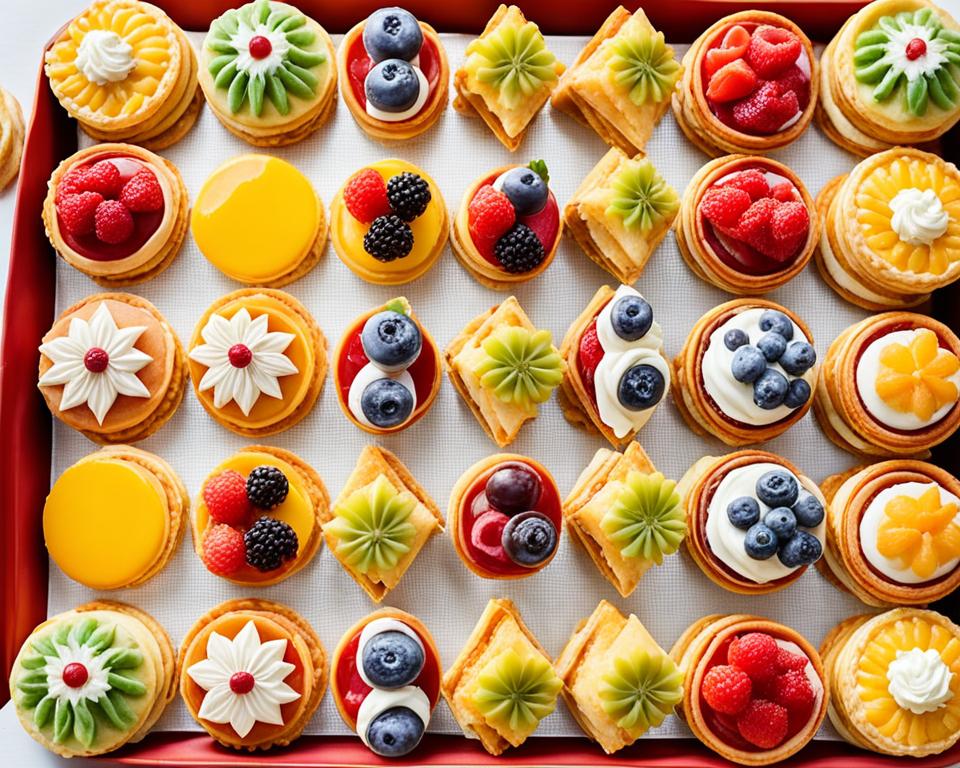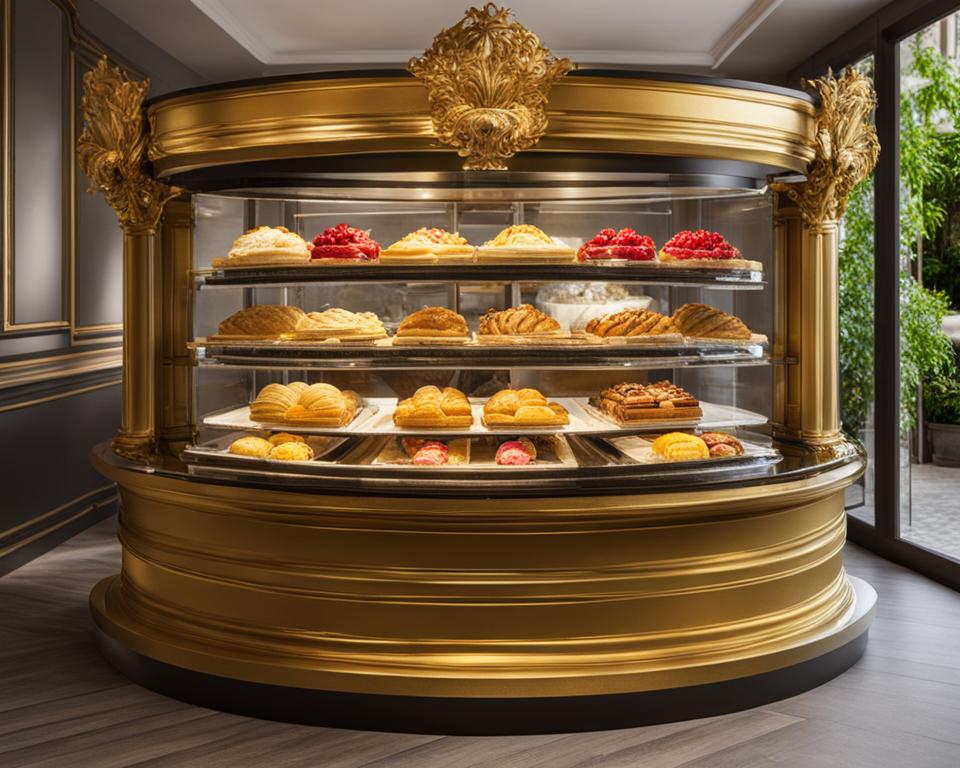When the days turn chilly and leaves start to blanket the ground, there’s nothing quite like the comfort of a homemade chicken pot pie. Known for its heartwarming ability to bring families together, this dish wraps tender chicken and savory vegetables in a golden brown crust. Each bite of the flaky pastry opens up to a steamy, creamy filling, offering a satisfying meal to fend off the cold. Be it a lazy Sunday or a bustling weeknight, these Flaky Chicken Pot Pie Recipes transcend time to become cozy meals cherished by all.
Key Takeaways
- Homemade chicken pot pies are quintessential warm and cozy meals perfect for cool weather.
- The golden brown crust, when paired with a creamy chicken filling, is the epitome of culinary comfort.
- These recipes are ideal for any family looking to indulge in the true essence of home-cooked warmth.
- Flaky Chicken Pot Pie Recipes can easily be customized to include favorite vegetables and seasonings.
- From preparation to presentation, the making of a chicken pot pie is both an art and a heartening tradition.
- With step-by-step guidance, even novice cooks can master the art of the perfect flaky crust.
Embracing the Comfort of Homemade Chicken Pot Pie
As the quintessence of classic comfort food, the homemade chicken pot pie stands alone. Its flaky crust, creamy filling, and fusion of hearty flavors have etched it into the culinary hearts as a family favorite. There’s a certain magic in preparing and sharing a dish that has the power to warm not just the body but also the soul, making each serving so much more than just a meal—it’s a timeless tradition that exudes warmth and well-being.
American kitchens have long celebrated the homemade chicken pot pie as the epitome of cozy comfort food. It resonates with the spirit of domestic bliss, where every ingredient added is a testament to care and a signature of personal touch. It’s this made-with-love approach that elevates a simple pie to an experience, encapsulating the joyous moments of sitting around the dinner table with loved ones.
The Allure of Classic Comfort Food
Indeed, the mere mention of chicken pot pie conjures images of steaming, savory pies emerging from the oven, with golden crusts promising delectable bites within. Crafting such a masterpiece at home means layering flavors with precision, starting from simmering the broth to perfecting the pastry—each step taken is part of the dance that makes classic comfort food not only palatable but also remarkable.
A Heartwarming Family Favorite Dish
In the pantheon of home-cooked meals, homemade chicken pot pie holds a special place, uniting generations at the family table. Whether adapted from a family recipe passed down through the years or innovated with a modern twist, it remains an undeniably cherished staple. As winter beckons or when the need for a hug in a dish arises, this timeless favorite is a call back to the hearths of our memories—always inviting, always satisfying.
The Secret to a Perfectly Flaky Pie Crust
When it comes to a flaky pie crust recipe, knowing the secret behind that perfect pie crust can elevate your chicken pot pie from good to great. The foundation of any pie lies in its crust, and achieving a golden brown crust is essential for that satisfying texture and taste. It’s not just about the flavor, but also about the delightful crunch that contrasts so well with the creamy filling inside.
Bakers have long understood the importance of temperature in making a flaky crust. Butter, the critical ingredient, must be very cold – if not almost frozen – to ensure the dough maintains those bits of fat crucial for the pastry’s layered structure. When the dough with these bits of butter is baked, they create steam, which puffs the dough up into multiple light, airy layers. If the butter has melted before baking, this effect can’t happen, and the crust will be denser.
- Start with very cold butter, cut into small cubes to maximally distribute throughout the flour.
- Minimize handling the dough with warm hands to prevent the butter from melting.
- Use a pastry cutter or food processor to mix butter into the flour, rather than kneading.
- Add a scant amount of vinegar to the dough, which inhibits gluten development for an even more tender crust.
- Chill the dough before rolling it out to keep it firm and manageable.
The mastery of these steps leads to the creation of the dream pie crust that home cooks and professional bakers alike strive for. Remember, patience and precise temperature control are your best friends in this endeavor.
Once the dough has been properly chilled and then rolled out, it’s time for the transformative baking process. At the right temperature and baking time, the small bits of butter melt in the heat of the oven creating those steam pockets, thereby elevating the humble ingredients to a sumptuous, golden-brown canvas awaiting the rich, savory filling.
The result is a crust that’s not just a vessel for the filling, but an integral part of the pot pie experience. A perfectly baked crust is one that harmonizes with its filling, providing just the right amount of flakiness without overpowering the aromatic chicken and vegetables nestled within.
Finding balance in your crust is a process, but one that pays off deliciously in the end. Whether you’re a seasoned pie-maker or new to the craft, the pursuit of the golden brown crust is a noble one. With cold butter, attentive handling, and a dash of vinegar, that coveted flaky pie crust will be yours to claim—and most importantly, to enjoy with each bite.
Flaky Chicken Pot Pie Recipes: A Step-by-Step Guide
Embarking on the journey of creating the quintessential comfort food starts with a simple yet delightful easy chicken pot pie recipe. The allure of a flaky crust embracing a hearty chicken dish elicits the homiest of feelings. Here, we lay out the essentials needed to master this staple of American comfort cuisine. You’ll find that with the right ingredients and a sequence of carefully honed steps, even the most novice of chefs can produce a pot pie worthy of family tradition.
Gathering Your Ingredients for an Easy Chicken Pot Pie Recipe
Before diving into the culinary mechanics of pie assembly, it’s crucial to curate high-quality ingredients that will come together harmoniously in your pot pie. A homemade pie crust, made from scratch, sets the tone for the texture and flavor profile of your pie. Meanwhile, a simple pot pie filling comprising tender chicken, vibrant vegetables, and a perfectly seasoned sauce will fill your kitchen with an aroma as inviting as the finished dish itself.
Mastering the Homemade Pie Crust
Every memorable chicken pot pie boasts a homemade pie crust with just the right amount of flakiness. The secret? Start with exceedingly cold butter, integrating it into the flour using deft, swift pulses in a food processor. Introducing a little ice water and a hint of vinegar will result in a dough that’s manageable yet delicate, laying the foundation for the golden-baked satisfaction to come.
Creating a Simple Pot Pie Filling with Hearty Chicken
With the pie crust chilled and ready to embrace its filling, shift your attention to preparing the heart of the pie. A medley of diced chicken, flavorful vegetables, and a rich creamy base come together to form a filling that’s robust yet simple enough to let the individual flavors shine. This combination, once baked within the flaky pastry confines, creates the treasured taste and texture that elevates the humble chicken pot pie to a nostalgic art form.
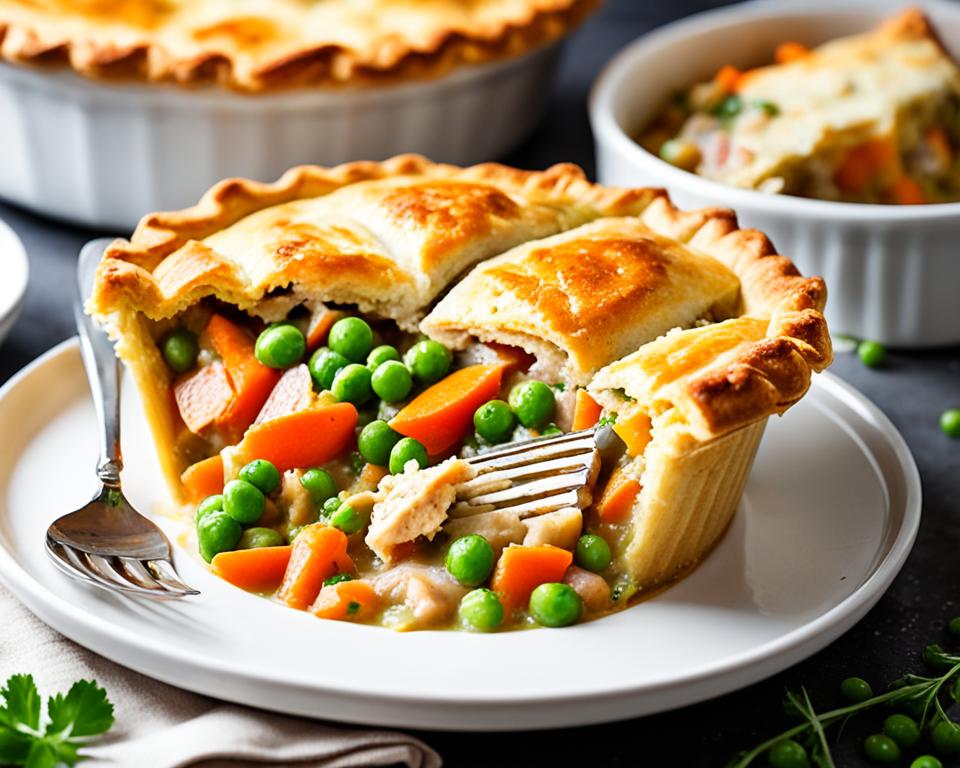
Cooking Techniques for a Flaky and Golden Brown Crust
Mastering the revered flaky golden brown crust of a chicken pot pie is a testament to skillful technique and precise temperature control. Below, we unravel the secrets that lead to this pastry perfection, guiding aspiring cooks to achieve that satisfying bite of golden bliss.
Keeping the Butter Cold for Optimal Flakiness
The first step in our cooking technique to achieve the ultimate flaky crust lies in the preparation of cold butter. It’s not just about using cold butter—freezing it before blending into your flour mixture can result in the most desirable texture. Tiny, cold butter bits throughout the dough explode into steam as they bake, puffing the dough into numerous light, flaky layers.
Rolling the Dough to the Ideal Thickness
Once you’ve mastered the use of cold butter, your next mission is rolling the dough. The goal is a uniform thickness that allows for an even bake and a structurally sound base to cradle your savory filling. A dough that is too thick will yield an undercooked, doughy texture, while too thin may lead to breaks and leaks. An even rollout ensures each slice of your pot pie has the perfect ratio of crust to filling.
Incorporating these key cooking techniques ensures each slice of pot pie is enrobed in a crust that’s both visually appealing and texturally perfect—soft enough to slice through effortlessly, yet stable enough to hold the rich, hearty filling within. Here’s a simple guide to follow:
| Technique | Description | Benefit |
|---|---|---|
| Using cold butter | Butter is cut into small cubes and frozen prior to incorporating into the flour. | Ensures butter remains solid, leading to steam pockets that create a flaky texture upon baking. |
| Minimize Dough Handling | Use tools like a food processor or pastry cutter to blend butter and flour, avoiding hand contact. | Prevents butter from melting due to body heat, keeping dough cold and flaky. |
| Consistent rolling | Dough is rolled to an even thickness, carefully monitored to avoid overworking. | Promotes uniform baking and the ideal crust-to-filling ratio. |
| Chilling the dough | Dough is refrigerated before rolling and once more before baking. | Preserves the structure of butter within the dough, contributing to flakiness. |
| Vinegar addition | A hint of vinegar is added to inhibit gluten development. | Enhances the tender texture of the finished crust. |
Through careful consideration of temperature and texture—using cold butter, avoiding overworking the dough, and rolling to just the right thickness—chefs and home cooks alike can look forward to the distinctive experience of a flaky golden brown crust that sets the standard for a memorable chicken pot pie.
Savoring the Flavors of Savory Chicken Pot Pie
The sheer delight of digging into a savory chicken pot pie is an experience that resonates with lovers of homemade comfort everywhere. As the flaky crust gives way to a world of rich flavors, each forkful is a homage to the time-honored recipes that have brought families together for generations. A treasure trove of tender chicken enveloped in a rich and creamy sauce, dotted with colorful and aromatic vegetables, invites you to savor each bite with gusto and appreciation.
The preparation of this hearty dish is no less important than the enjoyment it brings. It begins with the sautéing of onions and herbs, filling the kitchen with an enticing aroma that promises delicious things to come. The browning of the chicken pieces, followed by the slow simmer of the velvety sauce, creates a depth of flavor that’s hard to replicate. This intricate ballet of ingredients, diligently combined, sets the stage for a culinary masterpiece, eagerly anticipated by those gathered around the dining table.
The art of making chicken pot pie is a balance of precision and heart. It’s about crafting a dish that’s not only satisfying to the palate but also nourishing to the soul. The flaky crust, each layer of which tells a story of careful handling and patience, crowns a mixture of chicken and vegetables that have been seasoned to perfection. This is the substance of family dining, where a simple meal elevates into an extraordinary experience of homemade comfort.
The allure of savory chicken pot pie lies not just in its appetizing presentation but in its ability to encapsulate the essence of home cooking. A dish that celebrates the simple pleasures of life, the warm embrace of home, and the joy of shared experiences. The rich flavors emerging from this humble pie are a testament to the love poured into every step of its creation, from the peeling of the carrot to the last pinch of seasoned salt.
As we celebrate these time-honored traditions, let’s take a moment to indulge in the intricate flavors and textures that make savory chicken pot pie an unforgettable encounter with homemade comfort.
Why Using Both Cornstarch and Flour Enhances the Filling
When crafting the ultimate homemade chicken pot pie, achieving the perfect balance between consistency and flavor is essential. One might wonder how to reach that ideal pot pie richness that has tantalized taste buds for generations. The answer lies in utilizing both cornstarch and flour as thickening agents within the pie filling.
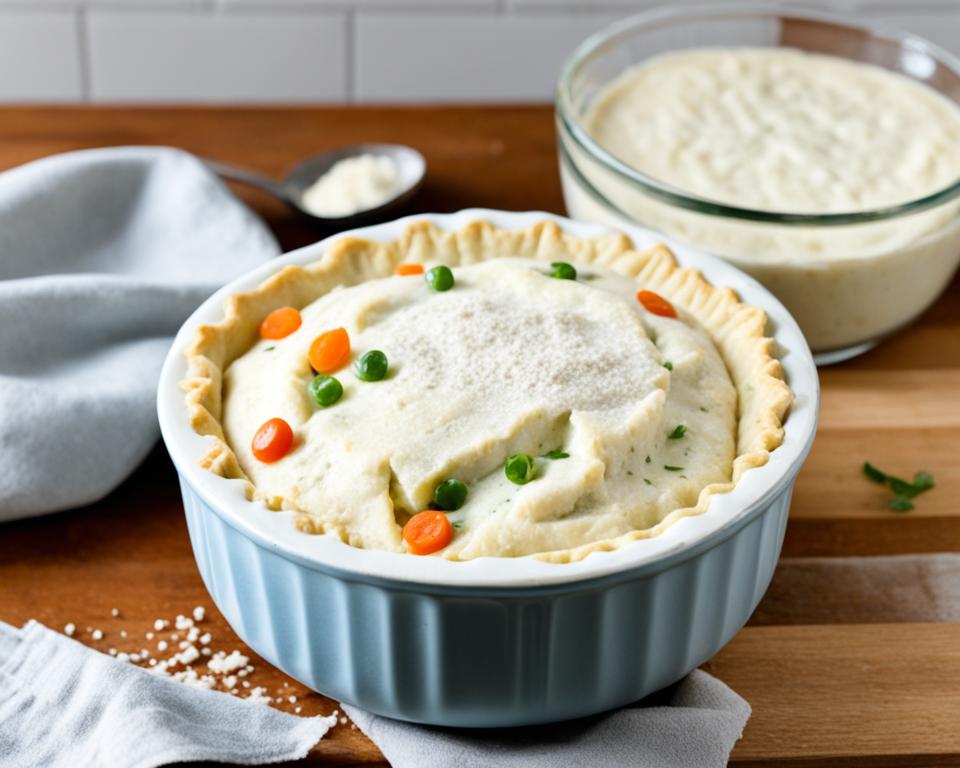
Balancing Consistency and Flavor in Your Pot Pie
The use of cornstarch and flour together may seem unconventional to some, but for culinary aficionados, it’s well-known that this combination leads to a pot pie filling that’s exceptionally rich and satisfying. Flour is known for its capacity to grant a heartier taste and a velvety texture, contributing to the overall depth of the pie’s flavor profile. On the other hand, cornstarch, revered for its light thickening power, provides a stable consistency without adding any distinct taste of its own.
Achieving the Perfect Thickness and Richness
Striking that delicate balance between too thick and too runny, the filling of a chicken pot pie should hold together nicely without being gelatinous or overly stiff. A well-calibrated mix of cornstarch and flour ensures that each spoonful is not only flavored perfectly but also scoops with ease, complementing the flaky texture of the crust in every bite. Combining these two provides both the desired consistency and a taste that lives up to the homely richness associated with this classic dish.
Below is an insightful table that depicts how cornstarch and flour, as thickening agents, individually contribute to the consistency and flavor of a chicken pot pie, and how their combination proves to be superior in fostering pot pie richness:
| Thickening Agent | Role in Consistency | Contribution to Flavor | Resulting Pot Pie Quality |
|---|---|---|---|
| Flour | Provides a thicker, more viscous consistency | Adds a rich, slightly nutty flavor to the filling | Creates a hearty and comforting filling, ideal for a robust pie experience |
| Cornstarch | Gives a lighter, firmer set to the pie filling | Neutral taste, ensuring the inherent flavors of the ingredients shine through | Results in a smooth, consistent filling that emphasizes natural flavors |
| Combination of Both | Achieves a perfect balance of firmness and spreadability | Maintains the heartiness of flour while preserving the filling’s authentic flavors | Delivers an optimally rich filling that complements the flaky pie crust |
By carefully considering the role each of these thickening agents plays, home cooks can elevate their homemade chicken pot pie to a level of quality that is not only deeply satisfying but also elegantly balanced, mirroring the best of traditional recipes with a nod to modern culinary understanding.
Choosing the Best Chicken for Your Pot Pie
For a perfect chicken pot pie, the quality of chicken used is imperative. The goal is to select the best chicken for pot pie to ensure each forkful is rich with flavor and the ideal, juicy chicken meat that defines excellent homemade comfort food. Let’s dive into the essential factors that make for the best chicken choice, all about achieving that perfect tenderness and succulence.
When selecting chicken for your pot pie, one should opt for cuts that are known for their moisture retention and soft texture. Chicken breast, with its lean profile, often needs extra care to avoid dryness. Methods like slow-roasting and sous vide are excellent for cooking chicken breast evenly and to precise doneness.
The slow-roasting technique allows heat to permeate gently, ensuring that the chicken breast does not lose excessive moisture yet reaches a safe, evenly cooked temperature. Conversely, the sous vide method involves sealing the chicken in a bag and cooking it in a water bath at a controlled temperature, which can result in unparalleled tenderness and moisture content.
To guide your cooking process, the following table illustrates the comparison between roasting and sous vide methods, suggesting that either can yield the superior juicy chicken meat necessary for a perfect chicken pot pie.
| Method | Description | Benefits |
|---|---|---|
| Slow Roasting | Even, gentle cooking in an oven | Retains moisture while achieving even doneness |
| Sous Vide | Precision cooking in a water bath | Produces supremely tender and moist chicken |
The choice of chicken not only impacts the overall texture but also fuses with the symphony of flavors inherent to the pot pie. Juicy, well-seasoned chicken complements the creamy vegetables and flaky crust for an unforgettable experience. Thus, whether one opts for traditional roasting methods or modern sous vide, the end goal is always to ensure maximum juiciness—a quintessential element of any perfect chicken pot pie.
Simple Freezing and Reheating Tips for Chicken Pot Pie
Nothing beats the convenience of having a homemade freezing chicken pot pie ready for those times when preparing a meal from scratch is not an option. With these simple tips, you can preserve the delightful flavors and textures of your pot pie, seamlessly transitioning from freezer to oven for a meal that tastes freshly made.
Preserving Your Hearty Chicken Dish for Later
When you have an abundance of pot pie, or you’re meal prepping for the future, preserving chicken dish such as a pot pie can be a lifesaver. The process is straightforward: allow your cooked chicken pot pie to cool completely. Cooling is essential to prevent ice crystals from forming within the pie, which can spoil its texture. Once cool, place it in the refrigerator to chill thoroughly before transferring it to the freezer.
How to Maintain the Quality of Your Pot Pie After Freezing
When the time comes to indulge in your preserved pie, reheating chicken pot pie correctly is vital. The goal is to keep the crust as flaky as it was when it first came out of the oven while ensuring the filling is heated evenly. Pop your frozen pot pie in the oven at around 375 degrees Fahrenheit, avoiding the necessity of thawing, and bake until the crust is crisp and golden.
| Step | Action | Tips |
|---|---|---|
| 1. Cool Down | Allow the cooked pie to reach room temperature. | Prevents sogginess and ice crystal formation. |
| 2. Chill | Refrigerate the pie to solidify the fats in the crust. | Aids in maintaining the crust’s structure during freezing. |
| 3. Freeze | Wrap the pie in plastic wrap and aluminum foil, then freeze. | Double wrapping prevents freezer burn and taste transfer. |
| 4. Reheat | Bake directly from frozen until hot and golden brown. | Ensures a flaky crust and avoids a soggy base. |
By meticulously following these freezing and reheating instructions, you can ensure your chicken pot pie retains its homemade appeal, delivering flaky pastry and succulent filling every time it’s served, regardless of when it was made. Allow these techniques to make your culinary life more practical while never compromising on taste and quality.
Best Pot Pie Recipes to Try at Home
The adventure of the home chef often leads to the timeless tradition of pot pie making. Within the realm of best pot pie recipes, there is a rich tapestry of recipe variations that have been tried and tested across countless kitchens. Home chefs can explore a diverse range of recipes that embody both time-honored recipes and innovative twists, each meeting unique taste preferences.
Exploring Variations for Every Taste Preference
Whether you prefer a classic chicken filling or seek a vegetarian option brimming with seasonal vegetables, there’s a pot pie to delight your palate. The versatility of pot pie recipes allows for endless experimentation with ingredients, from root vegetables and mushrooms for earthy depth, to a splash of lemon juice for a refreshing zest. The best pot pie recipes acknowledge diverse dietary needs and taste inclinations, ensuring a delectable experience for every diner.
Learning From Time-Honored Recipes and Innovations
Delving into the heart of pot pie mastery means learning from recipes that have been cherished and perfected over generations. These time-honored recipes provide the foundation upon which countless variations have been built, allowing for modern reinterpretations that still retain the soul of the original. From silky gravies ensconcing tender meat to the flakiest of pastries, the art of pot pie making continues to evolve, with each iteration taking its cue from the tried-and-true classics.
| Recipe Feature | Traditional Twist | Modern Innovation |
|---|---|---|
| Crust Type | All-butter classic pie crust | Gluten-free or whole wheat alternatives |
| Main Filling | Herb-roasted chicken or beef | Vegan options like lentils or tofu |
| Vegetable Medley | Carrots, peas, and potatoes | Seasonal vegetables, kale, or sweet potatoes |
| Flavor Enhancers | Rich stock and traditional spices | Lemon zest, fresh herbs, or exotic spices |
| Size Variation | Large family-style pie | Individual ramekin servings |
In the journey to create the best pot pie recipes at home, it’s the harmonious blend of high-quality ingredients, fusion of flavors, and the personal touch that results in not just a dish, but a story told by the hands of the one who cooks. From the comfort of the familiar to the thrill of the new, every pot pie has a narrative, seasoned perfectly to taste.
Customizing Your Chicken Pot Pie with Fresh Ingredients
The adventure of crafting a chicken pot pie is as much about combining savory staples as it is about embracing creative personalization. By customizing chicken pot pie with an array of fresh ingredients, each chef can transform the classic recipe into a unique culinary experience. Personal touches to the filling, including garden vegetables and flavorful herbs, enrich the dish, offering both a nutritional benefit and a burst of color on the plate. The result is a pot pie that not only caters to individual tastes but also elevates the entire meal to new heights of comfort cuisine.
Incorporating Garden Vegetables for Nutritional Boost
When customizing your pot pie, reaching into the garden for inspiration is the perfect way to ensure both freshness and nutrition. The vibrant garden vegetables—such as carrots, peas, and green beans—aren’t just visually appealing; they’re packed with essential vitamins and minerals. From leafy greens like spinach to sweet bell peppers, mixing these ingredients into the classic recipe not only diversifies flavor profiles but also contributes to a more wholesome dish.
Adding Personal Touches to the Classic Recipe
Classic recipe personalization allows the home cook to exercise culinary creativity. Experimentation might lead to incorporating a medley of mushrooms for an earthy twang or a touch of fresh thyme for aromatic depth. For meat lovers, options like slow-cooked turkey can replace traditional chicken, while vegetarians might opt for a hearty lentil or chickpea alternative. These personal touches don’t just alter taste; they transform the standard chicken pot pie into a signature dish reflective of the cook’s individual preference and flair.
| Ingredient | Role in Recipe | Nutritional Benefit | Personalization Ideas |
|---|---|---|---|
| Carrots | Color and subtle sweetness | Rich in beta-carotene and fiber | Try heirloom carrots for variety in color and taste |
| Green Beans | Crunch and freshness | Source of vitamins K and C | Mix with caramelized onions for a sweet twist |
| Spinach | Earthy taste and texture | High in iron and calcium | Sauté with garlic and a pinch of nutmeg to enrich flavors |
| Mushrooms | Meaty texture and umami | Contain protein and selenium | Wild mushrooms like shiitake or chanterelle add complexity |
| Lentils | Protein-packed filler | Great source of protein and fiber for vegetarians | Blend of green and red lentils for a mix of textures |
How to Serve Chicken Pot Pie for Any Occasion
Whether you’re planning a casual family night or hosting a more sophisticated soiree, knowing how to serve chicken pot pie can make all the difference in presentation and guest satisfaction. The versatility of pot pie for occasions allows it to blend seamlessly into the theme of any event, making it a go-to dish for hosts everywhere. Offering a feast for the eyes as well as the palate, the chicken pot pie presentation contributes significantly to the dining atmosphere.
For those intimate family dinners where comfort takes precedence over formality, serving a large, hearty chicken pot pie right from the oven in a beautiful pie dish can evoke feelings of warmth and nostalgia. The sight of the golden, flaky crust crackling slightly as it’s cut open—releasing the steam and sumptuous aroma from within—can turn a simple meal into an occasion in itself.
Conversely, in a setting where individual presentation is key, portioning the pot pie into elegant ramekins allows for a refined and personalized touch. Single servings ensure that the crust-to-filling ratio is perfect, and each guest gets an equal share of the blissful experience. This individualized approach speaks volumes about the host’s attention to detail and care for their guests’ dining pleasure.
Tying into the pot pie’s presentation, thoughtful accompaniments like a sprig of fresh thyme or a sprinkle of flaky sea salt can significantly enhance the visual appeal and taste. A garnish is more than just decoration—it’s an accent that can bring out the flavors in your pot pie and signify a thoughtful final touch.
| Occasion | Serving Style | Recommended Garnish |
|---|---|---|
| Family Dinner | Large pie dish, communal serving | A few sprigs of thyme for rustic charm |
| Formal Gathering | Individual ramekins | Edible flowers or a pinch of flaky sea salt for elegance |
| Casual Lunch | Slices on plates with simple side salads | Fresh herbs and a lemon wedge for a zesty touch |
| Outdoor Event | Hand pies for easy handling | Dusting of fine herbs for a flavorful bite |
In conclusion, ensuring your chicken pot pie looks as good as it tastes is a joyful endeavor that adds to the overall dining experience. The art of presenting and serving this beloved comfort dish can transform any ordinary meal into an extraordinary event.
Detailing Nutritional Information for Chicken Pot Pie Lovers
For those who cherish the rich flavors of comfort foods yet remain vigilant about their nutritional intake, breaking down the nutritional information of a hearty dish like chicken pot pie is key. Understanding the caloric makeup is essential, especially for dishes known for their sumptuous layers and creamy fillings. It’s here we discover how the beloved chicken pot pie fits within a balanced diet, while also considering the needs of those with specific dietary restrictions.
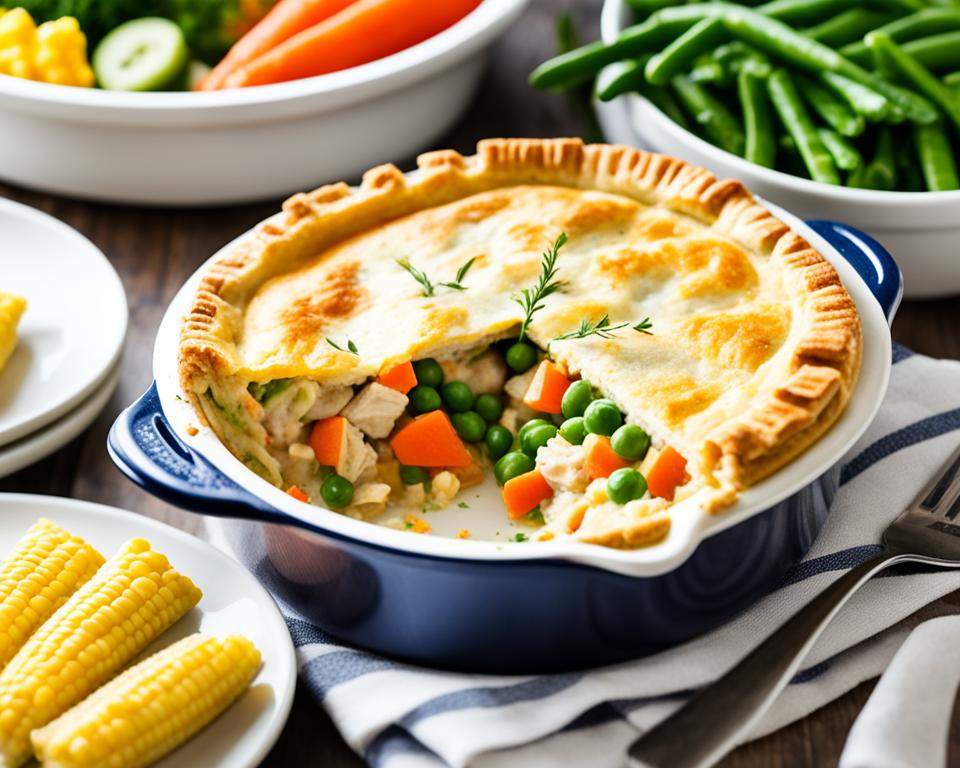
Understanding the Caloric Makeup of Comfort Foods
Chicken pot pie, a staple among comfort foods, combines various ingredients that altogether contribute to its total caloric value. For instance, the buttery crust and the creamy chicken filling, while delicious, add a significant number of calories to the dish. By scrutinizing the nutritional content, one can appreciate the caloric makeup of each component within the pot pie and assess how a serving fits into their daily caloric intake.
| Ingredient | Calories per Serving | Fat Content | Protein Content |
|---|---|---|---|
| Chicken Breast | 165 | 3.6g | 31g |
| Buttery Crust | 125 | 8g | 2g |
| Creamy Filling | 150 | 10g | 5g |
| Veggies (Carrots, Peas) | 40 | 0.2g | 1.4g |
How to Adjust Recipes for Dietary Restrictions
Adapting chicken pot pie recipes to accommodate various dietary restrictions doesn’t require a sacrifice in flavor or texture. By making thoughtful ingredient substitutions—such as gluten-free flour for a wheat-free crust, or dairy substitutes in the creamy filling—those with gluten or dairy sensitivities can still indulge in this home-style favorite. Low-sodium chicken broth can be used for those monitoring salt intake. Such adjustments ensure that the pot pie remains a staple on the table for everyone, aligning with diverse health and dietary considerations.
- Use gluten-free flour for the crust for guests with gluten intolerances.
- Opt for dairy substitutes like almond milk or coconut cream for lactose-free creaminess.
- Utilize low-sodium chicken broth to reduce salt content without losing depth of flavor.
- Select lean cuts of chicken and increase vegetable portions for a lower fat option.
By keeping abreast of the nutritional information and embracing adjustments for dietary restrictions, home cooks can ensure that their beloved chicken pot pie remains a comforting, yet health-conscious choice for all to enjoy.
Conclusion
Summing up the journey of exploring Flaky Chicken Pot Pie Recipes, we find ourselves entrenched in the warm embrace of this culinary classic. Through a blend of golden crusts and rich, savory fillings, the chicken pot pie rises as the ultimate comfort dish, uniting artisanal craft with heartwarming indulgence. The alchemy of making the perfect pot pie lies in meticulous attention to the balance of ingredients, mastery of cooking techniques, and the application of personal, refined touches that herald a dish’s transformation from simply homemade to unforgettable.
This wholesome staple transcends mere sustenance to become a conduit for memorable meals. Whether perfected through generations or infused with contemporary twists, the pot pie’s flakiness and robust flavor profile typify the best of homestyle fare. A creation that not only satisfies hunger but also soothes the soul, it embodies the essence of comfort food that anchors it firmly as a beloved addition to the American dinner table.
In closing, we celebrate the chicken pot pie not simply as a meal, but as a cherished experience rich in warmth and tradition. It impresses upon our palates the power of a simple pie to encapsulate the joy of eating—a perfect marriage of texture, flavor, and satisfaction that continues to kindle fond memories and forge new ones. Indeed, pot pies remain a linchpin of family heritage and gastronomic delight, echoing through kitchens as the perfect pot pie for any and all occasions.
FAQ
What makes a chicken pot pie crust flaky?
Achieving a flaky crust involves using very cold butter and gently handling the dough to prevent overworking it. Additionally, a small amount of vinegar can help inhibit gluten development, contributing to a tender crust.
Can chicken pot pie be considered a classic comfort food?
Absolutely, homemade chicken pot pie is a quintessential classic comfort food known for its creamy interior, flaky exterior, and warm, cozy appeal that makes it perfect for family gatherings and cozy meals.
What are the key ingredients for a simple pot pie filling?
The key ingredients for a simple pot pie filling include tender chicken, a mix of vegetables like peas and carrots, a rich creamy sauce for binding the mixture, and herbs and spices for added flavor.
How can you ensure that the pie crust is golden brown when baking?
To ensure a golden brown pie crust, bake the pot pie at the right temperature until the crust is thoroughly cooked and has a rich, golden hue. An egg wash can also be applied to the crust before baking to achieve a more golden color.
Are there any tips for making the perfect homemade pie crust?
Yes, some tips for making the perfect homemade pie crust include keeping all the ingredients, especially the butter, very cold; working the dough as little as possible; and chilling the pie crust before filling and baking it.
Why should both cornstarch and flour be used in pot pie fillings?
Using both cornstarch and flour in pot pie fillings provides the right balance in consistency, flavor, and thickness. Flour adds a richness and heartier taste, while cornstarch offers firmness without affecting the flavor profile.
How can I choose the best chicken for my pot pie?
For the best results in your pot pie, choose juicy and well-cooked chicken meat. Chicken breast is often preferred for its tenderness and can be roasted or cooked using methods like sous vide to ensure it remains juicy.
What are some effective freezing and reheating tips for chicken pot pie?
To freeze chicken pot pie, cool the cooked pie completely before wrapping and placing in the freezer. For reheating, bake the pie directly from frozen to ensure a crisp crust and evenly heated filling.
Can I customize chicken pot pie recipes to fit my dietary needs?
Certainly! You can adjust the recipe to fit dietary restrictions by using gluten-free flour, dairy substitutes, or low-sodium ingredients to create a healthier version of the classic pot pie.
How do I serve chicken pot pie for different occasions?
Chicken pot pie can be served in various ways to suit different occasions. For casual family meals, a large pie served in slices is perfect, while individual ramekin servings can be elegant for formal events. Fresh garnishes can add a special touch regardless of the occasion.
What are some variations of pot pie recipes I can try?
There are numerous variations of pot pie recipes that include different crust options like all-butter crusts, a variety of filling combinations with various meats, vegetables, or even vegan alternatives, and seasonings that can range from traditional to more modern, global flavors.
How can I incorporate vegetables into my chicken pot pie for a nutritional boost?
You can add a variety of garden vegetables such as carrots, peas, corn, and potatoes to your chicken pot pie for added nutrition and flavor. You can also experiment with leafy greens, bell peppers, and other colorful vegetables for increased nutritional value.
How do I balance the richness of the pot pie while considering its caloric makeup?
To balance the richness and caloric content, focus on using leaner cuts of chicken, increasing the amount of vegetables, and possibly reducing the amount of cream or butter in the filling. Portion control can also help manage the calorie count without compromising on flavor.

